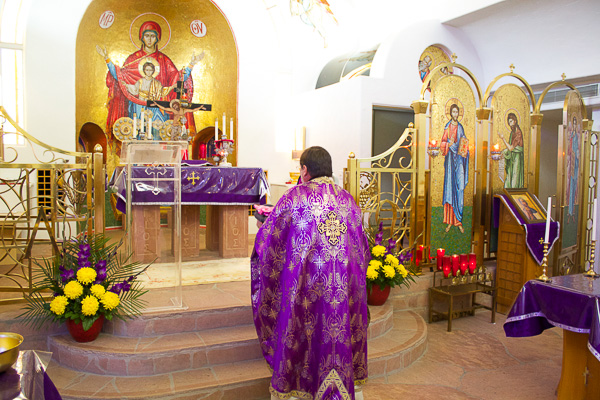
As some of you may know from my previous posts, my sister gave birth to a healthy baby girl back in February. She’s become the center of everyone’s heart and it’s so precious to see her develop her own little personality.
There is something that people of the Greek Orthodox faith do (not too sure if any other religions do this as well) when a baby is born. It’s called,”Σαραντισμός” (Sarantismos) or the 40 day blessing. Another name you may find is: churching. This is because the mother is blessed as well to aid in a speedy recovery after childbirth.
I’ve been wanting to write this post for some time, just because I thought it be nice to give people who may have never heard of it or experienced it an little insight. Hope you enjoy it!
History behind the 40 day blessing
It comes from the New Testament (Luke 2:22-24) where it informs us that the Virgin Mary brought Christ to the temple to present him to God 40 days after he was born. At the time, it was a common Jewish practice to bring the first-born male to the temple and offer him to the Lord. It was there, that a man by the name of “Simeon” had been waiting, some say 200 years, to meet Jesus. When Simeon took the baby from the Virgin Mary’s arms, he recited the following:
LORD NOW LET YOUR SERVANT GO IN PEACE ACCORDING TO YOUR PROMISE, BECAUSE MINE EYES HAVE SEEN YOUR SALVATION WHICH YOU HAVE PREPARED IN THE PRESENCE OF ALL PEOPLE, A LIGHT SHOWN TO THE GENTILES, AND FOR GLORY TO YOUR PEOPLE ISRAEL.
(The Orthodox Church still says this every evening during vesper services)
Therefore, on the 40th day, Greeks bring their children to the church to recreate this event. For those wondering, it doesn’t have to be done on the 40th day exactly, it’s normally performed on a Sunday as close to the 40 days as possible, but never more than 40 days after childbirth.
The 40 Day Blessing/Churching performed today
Like most religions and churches, each Father (or priest) does things in their own way. I will describe how we did it, others may experience something slightly different.
The Σαραντισμός (Sarantismos) is normally conducted after a Sunday service. It is a private ceremony that last about 10 minutes. Once the church attendees have moved on into the hall to discuss life over Greek coffee and pastries, the mother and child head to the narthex (the name given to it in Byzantine times) or lobby/entrance of the church. If the husband would like to be present he can accompany them, and in the case of my sister’s ceremony, her husband was there.
As a side note, my niece (ανιψιά μου) slept the whole time and the Father didn’t want to wake her so he carried her around the church in her carseat!
While the mother, father, and baby stand at the narthex, the Father, in the spirit of Simeon, begins the ceremony. He starts to recite the prayer given during the Sarantismos. If you would like to read what the Father says, click here: 40 day blessing Prayer.
After the Father recites the prayer, he then takes the baby, turns around and walks towards the front of the church, the parents following behind. As he walks holding the baby, he proclaims:
The servant of God is brought within the church in the name of the Father, and the Son, and the Holy Spirit. Amen.
Once they approach the εἰκονοστάσι (eikonostási) or icon stand, the front of the church that separates the nave from the sanctuary, the Father bows and says a prayer at center, left, and right. You can see the icon wall below:

Once the three prayers are complete, the Father then turns and hands the baby back to the mother as the ceremony is completed. Thus, the baby has officially been introduced to God and now able to receive all His glory.
Conclusion
It was a very touching experience. To see my little niece being carried by the Father of the church, and knowing that this was her first experience with God, was moving. It’s a special ceremony and of course with anything involving a baby, you can’t help but smile the whole time.
The next step is the baptism, which will take place this summer and I’ll be sure to write about that experience as well. It will be extra special not only because it’s my niece, it’s also due to the fact that both Jane and I will be her godparents: nouno/nouna.
We hope you enjoyed learning a bit more about the Σαραντισμός/40 day blessing. If your faith does anything different or if you’ve experienced the 40 day blessing, we’d love to know about it!
Yiasou
Kenton
Notes: I’m not well versed in the Greek Orthodox faith as others I know, so thanks to the following for help and Father Pantels for a wonderful ceremony. Websites of reference: The Greek Orthodox Church Of Our Saviour, Annunciation Greek Orthodox Church, Sts. Constantine and Helen Greek Orthodox Church, Apostoliki Diakonia (in Greek).



This was amazing to learn. I found a cake post on my favourite bakery’s instagram account with the inscription ‘Happy 40 Days…’ and I did not have a clue on what it meant. Until now. Thanks for sharing your culture and wisdom!
I’ve just been invited to my Grandson’s blessing in 2 weeks! I’m happy to know what it’s about- thank you, perfect timing!
Our grand daughter’s blessing is this weekend, and we are Roman Catholic. Thanks for the insight into this Greek Tradition!
Is it customary to pay the Priest for the 40 day blessing, and if do, how much?
Hmm, this is a tough one…Regarding the 40-day blessing, it’s a thoughtful gesture to offer something to the priest. The amount really depends on what you’re comfortable with. There’s no right or wrong amount here – it’s more about the spirit of giving and gratitude. Remember, your contribution, big or small, is a way of showing appreciation and support for the church’s ongoing work and services.